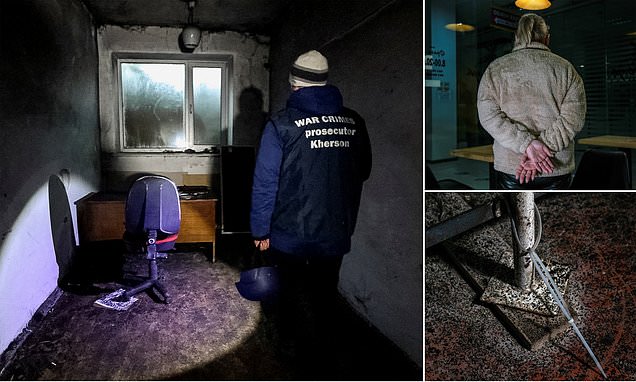
Inside the Russian torture chamber: Chilling photos show the dark rooms where Putin’s forces are said to have subjected hundreds of Ukrainians to unspeakable crimes
- Chilling photos show torture rooms said to have been used by Russian troops
- The images emerged from the liberated city of Kherson in southern Ukraine
Grim, filthy and comfortless, these are the dark chambers where Russia is said to have subjected hundreds of Ukrainians to unspeakable torture.
The images have emerged from the liberated city of Kherson in southern Ukraine.
Kyiv’s war crime investigators are piecing together the shocking story of what happened during the weeks that the city was occupied by Russian troops from March to November 2022.
They say that nearly half the Ukrainians captured by Russia since the conflict began have been tortured.
Their findings are based on a cohort of 320 detainees held at Russian ‘torture centres’ in Kherson. Of these, 43 per cent were seriously mistreated. The figure is supported by detailed testimonies and medical examinations.
A war crime prosecutor inspects a basement of an office building, where prosecutor’s office says 30 people were held for two months
Oksana Minenko, 44-year-old, shows how she was tortured by occupying Russian forces
Plastic ties for torture are seen inside the basement of the office building in Kherson, Ukraine
Plastic ties for torture and a broken chair are seen inside the basement in Ukraine where 30 people are understood to have been kept for two months
A Ukrainian policeman walks in a basement of the regional police headquarters, allegedly used as a torture site of pro-Ukrainian citizens
A view shows the entrance to the basement where dozens of Ukrainians are said to have been tortured
READ MORE: RUSSIA THREATENS USE OF NUCLEAR WEAPONS IN RETALIATION FOR DRONE STRIKE
At least 35 ‘torture chambers’ have also been identified in the city and the surrounding region. The victims, Ukrainian soldiers and civilians alike, were subjected to genital electrocution, brutal beatings and waterboarding.
Their Russian captors threatened them with genital mutilation and rape to extract information.
Three Ukrainians died in captivity in Kherson while many others suffered long-term physical damage.
Today, despite a series of prisoner swaps agreed by the warring parties, more than 3,000 Ukrainians remain in Russian captivity. It is feared these are also being mistreated.
Ukrainian official Anna Mykytenko said: ‘This [evidence] is just a fraction of what is taking place. I would expect many more cases of torture to emerge.
‘A lot was punishment [at the Kherson detention centres] for being a Ukrainian, for their service and, if they were civilians, for having family members in the military.
‘In relation to men, there were many cases of sexual torture as a form of punishment and this punishment may prevent them from having children in the future.’
Such horrific mistreatment of prisoners of war is a flagrant breach of the Geneva Convention. While captured troops may be detained for lengthy periods, they must be treated respectfully.
‘The pattern we are observing is consistent with a cynical and calculated plan to humiliate and terrorise millions of Ukrainian citizens to subjugate them to the will of the Kremlin,’ said Wayne Jordash KC. The senior lawyer from the Global Rights Compliance law firm, is helping to co-ordinate investigations led by Ukraine’s Office of the Prosecutor General.
He added: ‘I would be surprised if, after examining the war crimes and crimes against humanity, that the genocidal intent of many [Russian] soldiers in the occupied territories is not established.’
The study of detention centres in Kherson is part of a wider investigation by Ukraine’s OPG.
During the occupation of the Kherson area, Russian intelligence agents and officers, assisted by collaborators, established the network of 35 suspected torture chambers. They detained civilians and soldiers for ‘crimes’ as minor as having pro-Ukrainian content on a phone. But they were also reckless, using each other’s real names and rarely hiding their faces – so many have been identified.
Seventeen cases of genital electrocution have been linked to the same Russian officer. After the conflict, UK lawyers intend to pursue prosecutions at the International Criminal Court.
Source: Read Full Article






